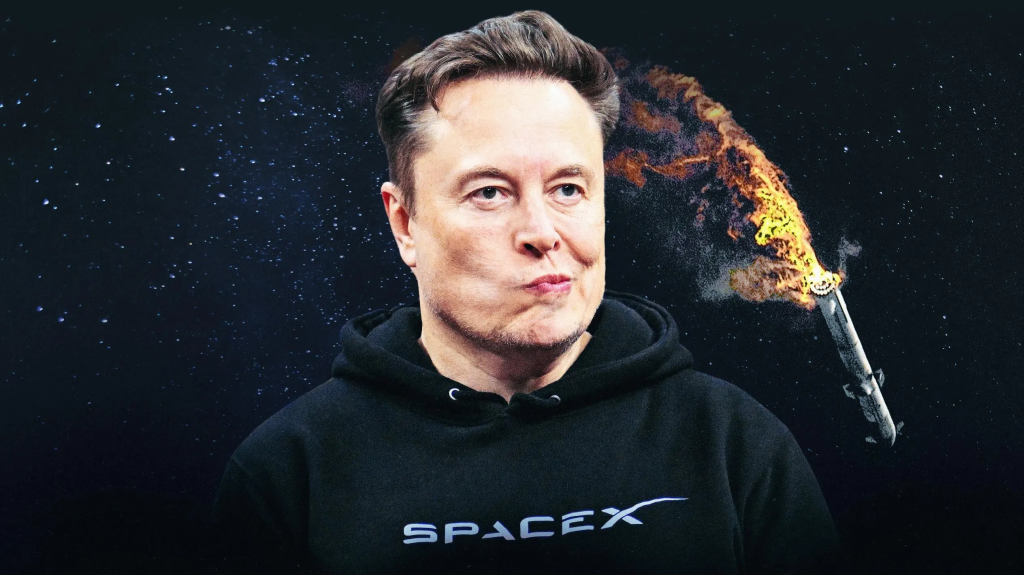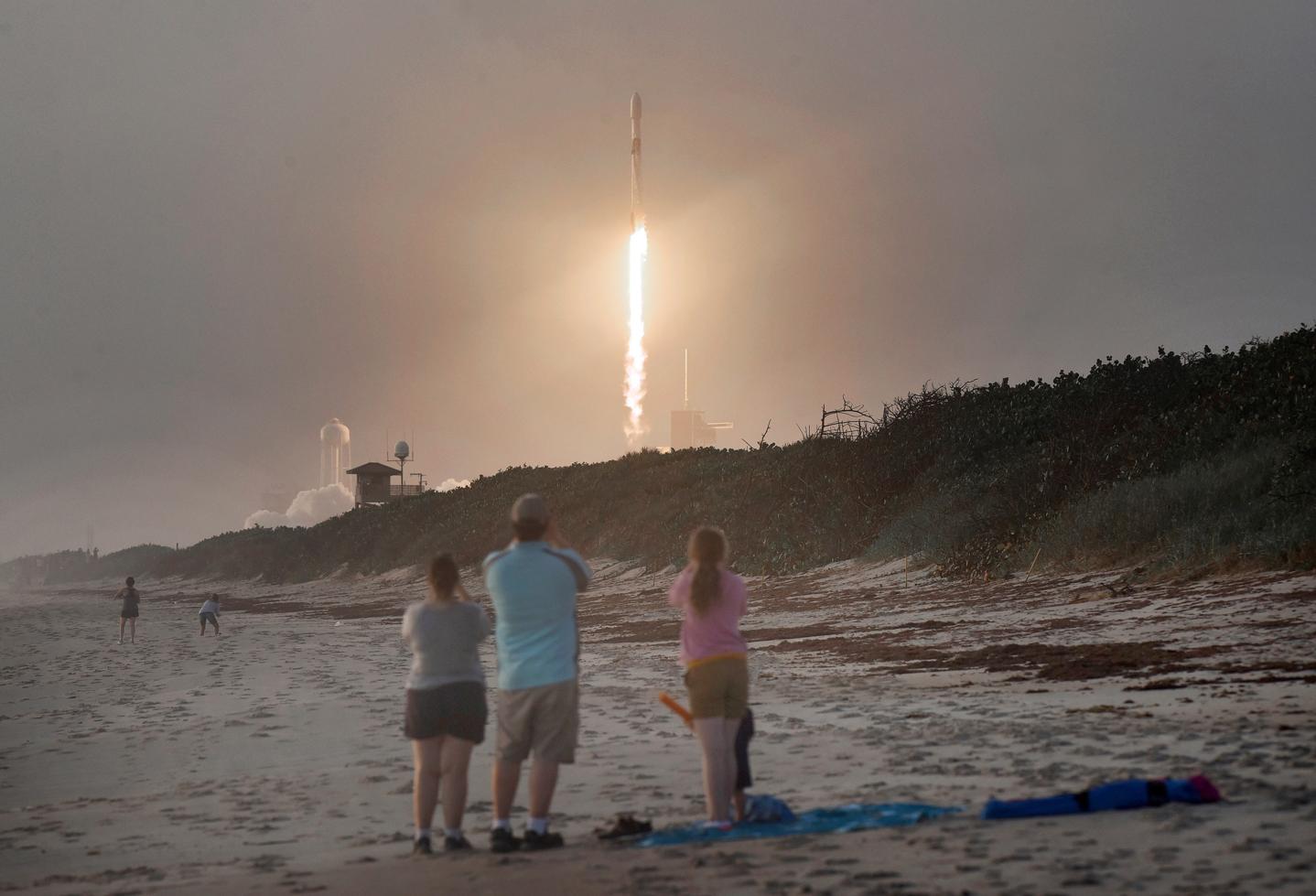While DOGE dismay has hammered Tesla stock, SpaceX is still flying high with investors as the world’s most valuable private company. But economic realities and the physical limits of beaming internet connectivity from space could puncture the good vibes.

Settling other planets isn’t going to be cheap. That’s why Elon Musk, after setting out to develop lower-cost rockets at SpaceX, decided to make money with them by launching a satellite network called Starlink to sell broadband internet access to ruralites. “Starlink is how we are paying for humanity to get to Mars,” he wrote on his social network X last year.
Starlink’s progress has been stunning. In March, less than five years after starting service, it reached 5 million customers, more than doubling the market of the previous satellite communications incumbents, Viasat and Hughes, at their height. Sunny expectations for Starlink are one of the main reasons investors have been eager to pump money into SpaceX. Its valuation hit $350 billion in December in a sale of insider shares, making it the most valuable private company in the world.
That valuation has largely held steady on secondary markets this year even as shares in Musk’s electric car maker Tesla have plummeted 55% from a record high reached in mid-December amid faltering sales and public fury over his role in the Trump administration and embrace of right-wing nationalists in Europe.
But some fear SpaceX, too, could face a reckoning, with the upside for Starlink not as high as investors seem to be betting. As with Tesla, it’s partly a question of how much they’re buying into Musk’s grand vision and their willingness to overlook financials.
“He keeps pulling rabbits out of hats, whether you believe them or not, about his robots or his self-driving cars or his city on Mars or his AI plans,” independent telecom consultant Tim Farrar told Forbes. “But I don’t think that Starlink alone as it exists today and the reasonable view of its future growth is going to support that sort of valuation.”
Sudden Acceleration
Rockets may be exciting, but the market for launching cargo into space isn’t huge–between $10 billion and $15 billion a year. Profits aren’t great, either. Telecom, however, is another story. With Starlink, SpaceX is angling for a share of a market worth over $1 trillion a year.
SpaceX has rapidly built a constellation of 7,100 satellites in low-Earth orbit—62% of all active spacecraft circling the planet, according to Harvard space watcher Jonathan McDowell. Starlink is making money from them by offering internet access to airplanes and ships, and peddling a military version called Starshield enhanced with secure communications and surveillance capabilities. It’s also competing with companies like AST SpaceMobile and Globalstar to enable emergency cellphone service in remote dead zones. But its biggest opportunity by far is in high-speed residential internet access, a market that the research firm Quilty Space expects to account for 63% of Starlink revenue this year.

Spectators watch as a SpaceX Falcon 9 rocket carrying 60 Starlink satellites launches from Kennedy Space Center at Cape Canaveral, Florida, in 2020.
NurPhoto via Getty Images
SpaceX doesn’t share financials, but Chris Quilty, founder of Quilty Space, estimates Starlink is on track to grow revenue 58% in 2025 to $12.3 billion, making it one of the fastest businesses to hit the 11-figure mark. “It’s staggering numbers,” he told Forbes. SpaceX President Gwynne Shotwell said late last year that Starlink had turned profitable.
Morgan Stanley analysts, led by longtime Tesla bull Adam Jonas, believe much greater heights are ahead: they’re projecting that in 2030, SpaceX will pile up $65 billion in revenue and $16 billion in net income, with Starlink accounting for 72% and 82%, respectively.
They’ve also argued that SpaceX’s growth prospects through 2026 could justify a valuation as much as double the current $350 billion, when looking at the multiples investors have given large, fast-growing public companies like Adobe and Intuitive Surgical.
But those bullish vibes ignore some of the hard ceilings Starlink faces. Its satellites simply aren’t capable of serving many internet customers in densely populated areas, and in rural regions the population that can afford to pay its high prices is limited. Starlink has yet to launch in many countries in Africa and Asia, but the wealth disparities there are worse than in most of the markets it’s currently serving, and in richer countries where it’s able to charge higher prices there may not be much room left to expand. Meanwhile, competing services are on the launchpad, including from rival billionaire Jeff Bezos’ Amazon.
“The valuation is not consistent with what are the technical realities of the constellation as we know it today,” Pierre Lionnet, an economist with the European trade association Eurospace, told Forbes.
Tight Beam
Think of the signals that Starlink satellites send to customers as the beam of a flashlight – the closer a satellite is to Earth, the narrower it is, allowing more beams to fit into a given area. Currently Starlink can’t manage that many.
Data on areas where Starlink is waitlisting new customers suggest it can serve only one to two customers per square kilometer, Farrar estimates. (Starlink’s capacity is tapped out in a number of regions, including around London and the Seattle-Portland area.) SpaceX has applied to regulators to lower the altitude of its satellites and use a wider range of radio frequencies, which is likely to be opposed. SpaceX is also promising big improvements in performance with its upcoming larger V3 satellites, which are designed to be launched by its still in development mega-rocket Starship. The company says they’ll be capable of beaming down 10 times more data to users than its V2 mini satellites. But even assuming that allows a density of 10 users per square kilometer, it wouldn’t pencil out to many customers in urban areas. In New York, for example, Starlink would be able to serve perhaps 7,000 households in a city of 8 million.
Cities, of course, are where the money is. Lionnet estimates that the maximum addressable market for Starlink in the 125 countries and territories it’s serving–as well as competitors—is 15 to 20 million customers, based on the distribution of people with the income to afford the service.
We’re not going to see a situation where things flip and Starlink is making all its money from tens or hundreds of millions of people in developing countries.
Tim Farrar
SpaceX has yet to win approval to start service in a number of nations, most notably India. But the opportunity there is more limited than many think despite its world-leading population of 1.4 billion, says Lionnet. Only 3% of Indian households have incomes over $35,000 a year, he notes.
“The opportunity for Starlink to increase their reach in India is only those 3% which do not already have access to the internet, which is probably a small fraction of those,” Lionnet said—perhaps a couple million households. “Sizable but not game-changing,” he said.
And it’s unlikely that Starlink can make much money off them. Broadband plans in India start at $12 a month. In the U.S., Starlink’s standard residential service goes for $120 a month. The company will have to heavily discount its prices to gain market share there, as it does in many emerging markets.
“Starlink makes most of its money from countries like the U.S. and Canada and Australia where it charges a lot for the service,” said Farrar. “We’re not going to see a situation where things flip and Starlink is making all its money from tens or hundreds of millions of people in developing countries.”
Pricing is key for SpaceX given the high costs of building and launching satellites. President Gwynne Shotwell said last year it had spent over $10 billion on Starlink so far. Then there are the terminals that users must buy to receive service, which most analysts believe SpaceX is selling at break-even cost, for $350 to $600.
There may not be a lot more upside in wealthy countries.
If the newest Starlink satellite lives up to SpaceX’s expectations, it could enable the company to compete with cable and telecom companies in U.S. suburban areas for perhaps “a high single-digit percentage” of the broadband market, said Farrar—but only if it cuts prices aggressively. The median home internet bill in the U.S. is $78 a month, according to CNET. And most terrestrial options offer higher speeds than Starlink. Last month, SpaceX took a first step toward dropping prices in the U.S., rolling out a lower-speed “lite” plan in 14 states for $80 a month.
Quilty Space estimates Starlink averaged $95 in revenue per user per month in 2024, and expects that to fall to $91 this year as it expands service in Asia and Africa.
Musk has never claimed that Starlink would do anything more than connect remote, sparsely settled areas that were too expensive to run fiber-optic cable to. “Starlink is not some huge threat to telcos. I want to be super clear: it is not,” he said at a satellite conference in 2020. He pegged the total business opportunity to be “as high as $30 billion a year.”
Morgan Stanley predicts Starlink will ring up $48 billion in revenue in 2030. Farrar’s assessment is more restrained; he thinks $20 billion is more likely.
Washington vs the World
SpaceX looks set to potentially win billions in new federal contracts under the Trump administration. That could include access to billions in federal subsidies to increase rural internet access that SpaceX was shut out of under the Biden administration. The U.S. government accounted for roughly a quarter of Starlink’s revenue in 2024, Quilty Space estimates.
But Starlink also risks losing billions in business internationally amid blowback over Musk’s ties to Trump and the administration’s isolationist tack on defense and trade. In response to U.S. tariffs, the Canadian province of Ontario canceled a $68 million contract with Starlink to hook up remote homes and businesses to high-speed internet. Italy has halted talks on a potential $1.5 billion deal for secure government communications amid outrage over threats to cut off Ukraine’s access to Starlink.

A Ukrainian soldier of the 61st Separate Mechanized Brigade sets up a Starlink antenna during exercises in Ukraine in 2023.
NurPhoto via Getty Images
The tension could be a boon for competitors that have struggled to keep up with Starlink and inspire more governments to launch their own satellite constellations, like Taiwan and the European Union, so as not to be overly reliant on Musk and the United States. Shares in Eutelsat, which operates the OneWeb LEO satellite network, have surged this year as the EU has looked to it to replace Starlink in Ukraine. The French company may well end up with the Italian contract rather than Starlink. The old-guard, geostationary satellite companies SES and Viasat are reportedly also in talks with European governments about replacing Starlink.
China is working on no less than three alternative constellations. The most advanced, government-owned SpaceSail, has launched 90 satellites out of a constellation planned to number 15,000 spacecraft by 2030, and it’s aggressively working to go international. The company has inked deals to offer service in three countries where Musk and Starlink have faced political trouble: Brazil, Kazakhstan and Malaysia.
But the biggest commercial threat may come from Amazon, which is planning a constellation of 3,200 satellites called Kuiper. As the world’s second-largest company by revenue, Amazon has unparalleled financial firepower to devote to the project, as well as the ability to leverage its AWS data storage business for ground infrastructure and to cross-sell to government and commercial customers. Its first 27 satellites are scheduled to be launched this week on a United Launch Alliance rocket.
Road to Mars
Starship is critical to the bull case for Starlink, and for SpaceX in general. The giant rocket, whose last two test launches ended with explosions in flight, has roughly four times the payload capacity of SpaceX’s Falcon 9 rocket. SpaceX designed its V3 satellite to take advantage of it. It’s three times heavier than the previous version, the V2 mini, and will be able to beam down 10 times the data — 1 Terabit per second. SpaceX is planning to pack 60 V3 satellites into Starship. That will enable it to put 20 times the bandwidth capacity into orbit with each launch compared to a Falcon 9 filled with V2 mini satellites. And since SpaceX has designed its satellites to last five years, it’s also soon going to have to replace a lot of old ones.
But if Starship delivers the sharply lower launch costs and high capacity Musk has claimed, some say it could spark an explosive new stage of growth in the space economy — tourism, manufacturing in space, and temporary space stations. Shotwell, who’s become a billionaire thanks to investors’ zeal for the company, believes Starship will take the company’s valuation higher still.
“Ultimately, I think Starship will be the thing that takes us over the top as one of the most valuable companies,” Shotwell said at an investment conference in November. “We can’t even envision what Starship is going to do to humanity and humans’ lives, and I think that will be the most valuable part of SpaceX.”
The economist Lionnet says there are no near-term signs of demand to support such heady predictions. Outside of Starlink, launch demand for communications satellites has stayed fairly flat. (SpaceSail, of course, isn’t putting its spacecraft on SpaceX rockets, and Amazon is only using Falcon 9 for three out of 80 planned launches.) Earth observation doesn’t require a lot of satellites. And space tourism? Even if launch costs are cut to $100 a kilogram, the ticket price per passenger would be over $100,000 given the weight of life support systems. “Who can pay that?”
Ultimately, with Musk’s companies, investing is a matter of faith, says Quilty. He recalls speaking with a leading money manager who effectively threw up his hands and decided to invest in SpaceX in a round where its valuation topped $100 billion. “He was like, ‘I’m not putzing around justifying the valuation here,’ ” Quilty recalled with a laugh. “You can’t get there by traditional metrics.”
This article was originally published on forbes.com and all figures are in USD.
Look back on the week that was with hand-picked articles from Australia and around the world. Sign up to the Forbes Australia newsletter here or become a member here.


